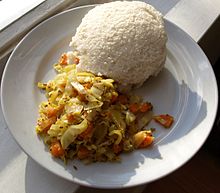- Rwandan cuisine
-
The cuisine of Rwanda is based on local staple foods produced by the traditional subsistence-level agriculture and has historically varied between the country's different ethnic groups.[1]
Contents
Background
Rwandan staples include bananas, plantains, pulses, sweet potatoes, beans, and cassava (manioc). Historically this is particularly true of the Twa and the Hutus who hunted and farmed. Their diet was high in vegetables and lacking in animal protein due to the small amount of animal products consumed. The Tutsis were traditionally pastoralists and consumed a higher amount of milk and dairy products.[1] Many Rwandans do not eat meat more than a few times a month.[1] For those that live near lakes and have access to fish, tilapia is popular.[1] The potato, thought to have been introduced to Rwanda by German and Belgian colonists, is now very popular and is cultivated in the towns of Gitarama and Butare.[2]
National dishes
Various dishes have evolved from the range of basic foods consumed. Ugali (or bugali) is a paste made from maize and water, to form a porridge-like consistency that is eaten throughout East Africa.[3] Isombe is made from mashed cassava leaves and served with dried fish.[2] Matoke is a dish made from baked or steamed plantains.[3]
In the restaurants in the capital city of Kigali, locals and expatriates eat a variety of international cuisine, including Indian, Chinese, Italian, French and African.[4] In other cities and towns, the cuisine is simpler, often consisting of chicken, fish, goat or steak served with rice or french fries.[4]
Beverages
Milk is a common drink among Tutsi pastoralists.[5] Other popular drinks in Rwanda include fruit juice, wine and beer.[6] Commercial beers drunk in Rwanda include Primus, Mützig and Amstel.[3] In rural areas, urwagwa is a beer made from the fermented juice of bananas that has been mixed with roasted sorghum flour.[7] Beers feature in traditional rituals and ceremonies and are generally consumed only by men.[2] Ikigage is an alcoholic beverage made from dry sorghum that is thought to have medicinal powers.[8] Ubuki is made from fermented honey and has an alcohol content of about 12 per cent.[9]
See also
References
Footnotes
Sources
- Adekunle, Julius (2007). Culture and Customs of Rwanda. Greenwood Publishing Group. ISBN 0313331774. http://books.google.co.uk/books?id=g0FC40EQujwC&pg=PA81.
- Auzias, Dominique (2007) (in French). Rwanda. Petit Futé. ISBN 2746920379. http://books.google.co.uk/books?id=TyMs5XGSIzQC&pg=PA73.
- King, David C. (2007). Rwanda. Marshall Cavendish. ISBN 0761423338. http://books.google.co.uk/books?id=1yLx1zSuh_QC&pg=PA129.
- Twagilimana, Aimable (1997). Hutu and Tutsi. The Rosen Publishing Group. ISBN 0823919994. http://books.google.co.uk/books?id=lNzPUpBW5UcC&pg=PA19.
African cuisine National cuisines - Algeria
- Angola
- Benin
- Botswana
- Burkina Faso
- Burundi
- Cameroon
- Cape Verde
- Centrafrican (Central African Republic)
- Chad
- Comoros
- The Republic of the Congo
- The Democratic Republic of the Congo
- Egypt
- Eritrea
- Ethiopia
- Gabon
- Ghana
- Ivorian (Côte d'Ivoire)
- Kenya
- Libya
- Madagascar
- Morocco
- Mozambique
- Namibia
- Nigerien (Niger)
- Nigerian
- Rwanda
- Senegal
- Sierra Leone
- Somalia
- South Africa
- Sudan
- Swaziland
- Tanzania
- Tunisia
- Uganda
- Zambia
- Zimbabwe
Ethnic and regional cuisines  Rwanda topics
Rwanda topicsHistory Politics Geography Economy and infrastructure Demographics and society Culture Index • Portal
This African cuisine-related article is a stub. You can help Wikipedia by expanding it.


